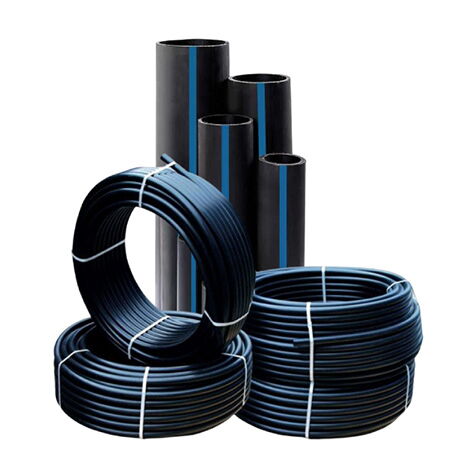High-density polyethylene (HDPE) plastic pipes are made from HDPE resin and are widely used across various industries due to their exceptional mechanical properties, chemical stability, and long lifespan. With high crystallinity and density, HDPE stands out among other piping materials, making it the preferred choice over traditional materials such as steel, cast iron, and cement pipes. As technology advances and demand grows, HDPE pipes have become an indispensable part of modern infrastructure, particularly in municipal, agricultural, industrial, and natural gas transportation applications.
HDPE pipes are renowned for their superior performance, including chemical stability, physical properties, temperature resistance, and UV resistance, making them suitable for a wide range of applications.
HDPE pipes offer excellent chemical resistance, enabling them to withstand corrosion from most chemicals. They are especially ideal for municipal water supply, wastewater disposal, and chemical transport. Their corrosion resistance surpasses that of traditional metal pipes, preventing leaks or damage caused by corrosion and ensuring long-term stability.
At room temperature, HDPE pipes exhibit outstanding mechanical properties. With a high density and crystallinity, they offer excellent abrasion resistance, impact strength, and durability. Even under extreme conditions or low temperatures, HDPE pipes retain their superior mechanical performance. Compared to other materials, HDPE pipes are lightweight, providing significant advantages in transportation and installation.
HDPE pipes have a broad temperature range, operating effectively from -40°C to +60°C. While their high-temperature resistance exceeds that of many plastic materials, prolonged exposure to high temperatures can affect their performance. Therefore, it is essential to consider environmental temperature conditions during design.
HDPE pipes have relatively poor UV resistance, and prolonged exposure to sunlight can cause aging, brittleness, and discoloration. To enhance UV resistance and extend their service life, many HDPE pipes are produced with carbon black or other UV-resistant additives.

The production of HDPE pipes involves several key steps:
Polymerization: Ethylene monomers are converted into HDPE resin through high-pressure polymerization. The choice of production process and catalysts directly affects the molecular structure and performance of the polyethylene.
Extrusion Molding: After melting the HDPE resin, extrusion molding is used to shape it into pipes. The temperature and pressure conditions during this process play a crucial role in the final performance of the pipes.
Cooling and Curing: The formed pipes undergo cooling and curing to ensure they harden without cracking or deforming during the process.
Post-Treatment: After production, pipes undergo surface treatment, marking, and cutting to meet various application requirements.
Thanks to their excellent physical and chemical properties, HDPE pipes offer notable advantages across many fields. Whether in corrosion resistance, wear resistance, or ease of installation, HDPE pipes provide more reliable and cost-effective solutions for various projects.
The chemical stability of HDPE pipes allows them to maintain a long service life in harsh environments. They are not affected by corrosion from soil or water, making them ideal for transporting potable water, wastewater, and chemicals.
HDPE pipes are highly resistant to impact and external pressure. Their impact strength and pressure resistance far exceed that of traditional pipes, making them especially suitable for underground installations and areas exposed to external pressure.
HDPE pipes are lighter than traditional steel and cement pipes, making them easier and quicker to install. This reduces construction difficulty and labor costs while shortening construction timelines. Additionally, HDPE pipes can be connected using heat fusion technology, ensuring a more secure, leak-free connection compared to traditional methods.
HDPE is a recyclable material, aligning with environmental protection standards. Using HDPE pipes reduces negative environmental impacts, as they do not release harmful substances during use, making them a safe and eco-friendly pipeline material.
Due to their superior performance, HDPE pipes are widely used in multiple industries. Whether in municipal engineering, agricultural irrigation, or industrial drainage systems, HDPE pipes have become the material of choice for many sectors, thanks to their strength, corrosion resistance, and ease of installation.
Municipal Water Supply and Drainage: HDPE pipes are widely used in water supply systems due to their corrosion and pressure resistance, making them ideal for urban water pipelines. Similarly, in sewage treatment and drainage systems, their anti-corrosion properties and long-term stability make them a common choice.
Agricultural Irrigation: With excellent flexibility and pressure resistance, HDPE pipes are widely used in agricultural irrigation systems, particularly for large-scale or underground irrigation systems, improving water efficiency and crop yields.
Chemical and Industrial Pipelines: HDPE pipes are increasingly used in chemical plants, petroleum pipelines, and mineral transport due to their resistance to chemical corrosion and wear, making them capable of handling corrosive and abrasive substances over long distances.
Natural Gas and Oil Pipelines: HDPE pipes are critical in the transportation of natural gas and liquefied petroleum gas (LPG) due to their resistance to high pressure and corrosion. Their impact resistance and aging resistance are also advantageous in hazardous environments.
Although HDPE pipes offer numerous advantages, they do have some limitations in specific applications.
While HDPE pipes perform well in many environments, they are sensitive to UV radiation. Prolonged exposure to sunlight accelerates aging, potentially leading to brittleness and discoloration. To mitigate this, manufacturers typically add UV stabilizers or use carbon black coloring agents during production.
Although HDPE pipes exhibit good high-temperature resistance, their performance is still limited at high temperatures. Continuous exposure to temperatures above 60°C may cause a decrease in performance. In high-temperature environments, selecting the right material for pipes is crucial.
Despite their strong impact resistance, HDPE pipes can still crack or break under extreme mechanical pressure, particularly in cold environments. Proper protective measures should be taken when using HDPE pipes in colder regions.
HDPE pipes, with their excellent corrosion resistance, impact strength, UV resistance, and environmental benefits, have become an indispensable part of modern pipeline systems. Whether in municipal, agricultural, industrial, or natural gas sectors, HDPE pipes have proven themselves to be highly effective, with broad market potential. While there are limitations such as UV aging and temperature resistance, these issues can be effectively addressed through material improvements and manufacturing processes.
